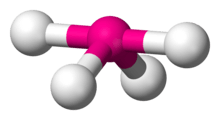Seesaw molecular geometry
Disphenoidal or Seesaw is a type of molecular geometry where there are four bonds to a central atom with overall C2v molecular symmetry. The name "seesaw" comes from the observation that it looks like a playground seesaw. Most commonly, four bonds to a central atom result in tetrahedral or, less commonly, square planar geometry.
| Seesaw molecular geometry | |
|---|---|
 | |
| Examples | SF4 |
| Point group | C2v |
| Coordination number | 4 |
| Bond angle(s) | Ideal ax-ax 180°, eq-eq 120°, ax-eq 90° SF4 ax-ax 173.1°, eq-eq 101.6° |
| μ (Polarity) | >0 |
It occurs when a molecule has a steric number of 5, with the central atom being bonded to 4 other atoms and 1 lone pair (AX4E in AXE notation). An atom bonded to 5 other atoms (and no lone pairs) forms a trigonal bipyramid; but in this case one of the atoms is replaced by a lone pair. The atom replaced is always an equatorial atom, because the lone pairs repel other electrons more strongly than atoms do.
Structure
Compounds with disphenoidal geometry (See-Saw Geometry) have two types of ligands: axial and equatorial. The axial pair lie along a common bond axis so that are related by a bond angle of 180°. The equatorial pair of ligands is situated in a plane orthogonal to the axis of the axial pair. Typically the bond distance to the axial ligands is longer than to the equatorial ligands. The ideal angle between the axial ligands and the equatorial ligands is 90°; whereas the ideal angle between the two equatorial ligands themselves is 120°.
Disphenoidal molecules, like trigonal bipyramidal ones, are subject to Berry pseudorotation. Thus, the 19F NMR spectrum of SF4 (like that of PF5) consists of single resonance near room temperature.[1] The four atoms in motion act as a lever about the central atom; for example, the four fluorine atoms of sulfur tetrafluoride rotate around the sulfur atom.[2]
Examples
Sulfur tetrafluoride is the premier example of a molecule with the disphenoidal molecular geometry (see image at upper right). The following compounds and ions have disphenoidal geometry:[3]
See also
- Molecular geometry
- AXE method
References
- Klemperer, Walter G.; Krieger, Jeanne K.; McCreary, Michael D.; Muetterties, E. L.; Traficante, Daniel D.; Whitesides, George M. (1975). "Dynamic nuclear magnetic resonance study of fluorine exchange in liquid sulfur tetrafluoride". J. Am. Chem. Soc. 97: 7023–7030. doi:10.1021/ja00857a012.
- "Illustration of the Berry pseudorotation".
- Seesaw Molecular Geometry, AX4E1 25 Dec 2007 Archived November 3, 2014, at the Wayback Machine
External links
- Chem| Chemistry, Structures, and 3D Molecules
- Indiana University Molecular Structure Center
- Interactive molecular examples for point groups
- Molecular Modeling
- Animated Trigonal Planar Visual
- VSEPR